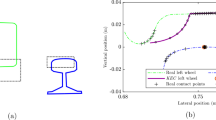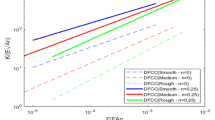Abstract
The main purpose of this paper is to develop a simple-model moving wheel/rail contact element, so that the sticking, sliding, and separation modes of the wheel/rail contact can be appropriately simulated. In the proposed finite element, the wheel and rail are simulated using the cubic-spline contact element, and a power function normal stiffness and a constant horizontal stiffness are connected to the cubic-spline contact stiffness. The three-dimensional (3D) contact finite element analysis for a realistic wheel and rail was used to accurately model the wheel/rail contact stiffness. The validated examples show that the proposed nonlinear moving wheel element can simulate the complicated sliding, sticking, and separation contact problems with good accuracy. The complicated contact modes, including the multiple contact situation between wheel flange and rail side, can also be simulated accurately. Moreover, the computer memory and CPU time required to achieve this are much less than needed with the 3D finite element contact model.









Similar content being viewed by others
References
Lin, Y.H., Trethewey, M.W.: Finite element analysis of elastic beams subjected to moving dynamic loads. J. Sound Vib. 136(2), 323–342 (1990)
Fryba, L.: Vibration of Solids and Structures Under Moving Load. Thomas Telford, London (1999)
Bowe, C.J., Mullarkey, T.P.: Wheel–rail contact elements incorporating irregularities. Adv. Eng. Softw. 36(11–12), 827–837 (2005)
Sun, Y.Q., Dhanasekar, M., Roach, D.: A three-dimensional model for the lateral and vertical dynamics of wagon-track systems. Proc. Inst. Mech. Eng., Part F J. Rail Rapid Transit 217(1), 31–45 (2003)
Ju, S.H., Lin, H.D., Hsueh, C.C., Wang, S.L.: A simple finite element model for vibration analyses induced by moving vehicles. Int. J. Numer. Method Eng. 68(12), 1232–1256 (2006)
Xiao, X.B., Wen, Z.F., Jin, X.S., Sheg, X.Z.: Effects of track support failures on dynamic response of high speed tracks. Int. J. Nonlinear Sci. Numer. Simul. 8(4), 615–630 (2007)
Rathod, C., Shabana, A.A.: Geometry and differentiability requirements in multibody railroad vehicle dynamic formulations. Nonlinear Dyn. 47(1–3), 249–261 (2007)
Dinh, V.N., Kim, K.D., Warnitchai, P.: Simulation procedure for vehicle–substructure dynamic interactions and wheel movements using linearized wheel–rail interfaces. Finite Elem. Anal. Des. 45(5), 341–356 (2009)
Recuero, A.M., Escalona, J.L., Shabana, A.A.: Finite-element analysis of unsupported sleepers using three-dimensional wheel–rail contact formulation. Proc. Inst. Mech. Eng. Part K J. Multi-Body Dyn. 225(2), 153–165 (2011)
Yang, Y.B., Lin, B.H.: Vehicle–bridge interaction analysis by dynamic condensation method. J. Struct. Eng.-ASCE 121(11), 1636–1643 (1995)
Au, F.T.K., Wang, J.J., Cheung, Y.K.: Impact study of cable-stayed railway bridges with random rail irregularities. Eng. Struct. 24(5), 529–541 (2002)
Kwark, J.W., Choi, E.S., Kim, Y.J., Kim, B.S., Kim, S.I.: Dynamic behavior of two-span continuous concrete bridges under moving high-speed train. Comput. Struct. 82(4–5), 463–474 (2004)
Xia, H., Zhang, N.: Dynamic analysis of railway bridge under high-speed train. Comput. Struct. 83(23–24), 1891–1901 (2005)
Xia, H., Han, Y., Zhang, N., Guo, W.W.: Dynamic analysis of train–bridge system subjected to non-uniform seismic excitations. Earthq. Eng. Struct. Dyn. 35(12), 1563–1579 (2006)
Auersch, L.: The excitation of ground vibration by rail traffic: theory of vehicle–track–soil interaction and measurements on high-speed lines. J. Sound Vib. 284(1–2), 103–132 (2005)
Xi, S., Andreas, P.A.: Measurement and modeling of normal contact stiffness and contact damping at the meso scale. Trans. ASME 127(1), 52–60 (2005)
Lei, X., Zhang, B.: Analyses of dynamic behavior of track transition with finite elements. J. Vib. Control 17(11), 1733–1747 (2011)
Gupta, S., Degrande, G., Lombaert, G.: Experimental validation of a numerical model for subway induced vibrations. J. Sound Vib. 321(3–5), 786–812 (2009)
Connolly, D., Giannopoulos, A., Forde, M.C.: Numerical modelling of ground borne vibrations from high speed rail lines on embankments. Soil Dyn. Earthq. Eng. 46, 13–19 (2013)
Seo, J.H., Sugiyama, H., Shabana, A.: Three-dimensional large deformation analysis of the multibody pantograph/catenary systems. Nonlinear Dyn. 42(2), 199–215 (2005)
Tanabe, M., Matsumoto, N., Waku, H., Sogabe, M., Okuda, H.: A simple and efficient numerical method for dynamic interaction analysis of a high-speed train and railway structure during an earthquake. J. Comput. Nonlinear Dyn. 3(4), Article Number 041002 (2008)
Dinh, V.N., Kima, K.D., Warnitchai, P.: Dynamic analysis of three-dimensional bridge–high-speed train interactions using a wheel–rail contact model. Eng. Struct. 31(12), 3090–3106 (2009)
Nishimura, K., Terumichi, Y., Morimura, T., Sogabe, K.: Development of vehicle dynamics simulation for safety analyses of rail vehicles on excited tracks. J. Comput. Nonlinear Dyn. 4(1), Article Number 011001 (2009)
Li, Q., Xu, Y.L., Wu, D.J., Chen, Z.W.: Computer-aided nonlinear vehicle–bridge interaction analysis. J. Vib. Control 16(12), 1791–1816 (2010)
Ju, S.H.: A simple finite element for nonlinear wheel/rail contact and separation simulations. J. Vib. Control 20(3), 330–338 (2014)
Pombo, J., Ambrosio, J.: An alternative method to include track irregularities in railway vehicle dynamic analyses. Nonlinear Dyn. 68(1–2), 161–176 (2012)
Antolin, P., Zhang, N., Goicolea, J.M., Xia, H., Astiz, M., Oliva, J.: Consideration of nonlinear wheel–rail contact forces for dynamic vehicle–bridge interaction in high-speed railways. J. Sound Vib. 332(5), 1231–1251 (2013)
Kouroussis, G., Verlinden, O.: Prediction of railway ground vibrations: accuracy of a coupled lumped mass model for representing the track/soil interaction. Soil Dyn. Earthq. Eng. 69, 220–226 (2015)
Montenegro, P.A., Neves, S.G.M., Calcada, R.: Wheel–rail contact formulation for analyzing the lateral train–structure dynamic interaction. Comput. Struct. 152, 200–214 (2015)
Ju, S.H.: A cubic–spline contact element for frictional contact problems. J. Chin. Inst. Eng. 21(2), 119–128 (1998)
Acknowledgments
This study was supported by the National Science Council, Republic of China, under contract number: NSC97-2221-E-006-116-MY3.
Author information
Authors and Affiliations
Corresponding author
Rights and permissions
About this article
Cite this article
Ju, S.H. A frictional contact finite element for wheel/rail dynamic simulations. Nonlinear Dyn 85, 365–374 (2016). https://doi.org/10.1007/s11071-016-2691-7
Received:
Accepted:
Published:
Issue Date:
DOI: https://doi.org/10.1007/s11071-016-2691-7




